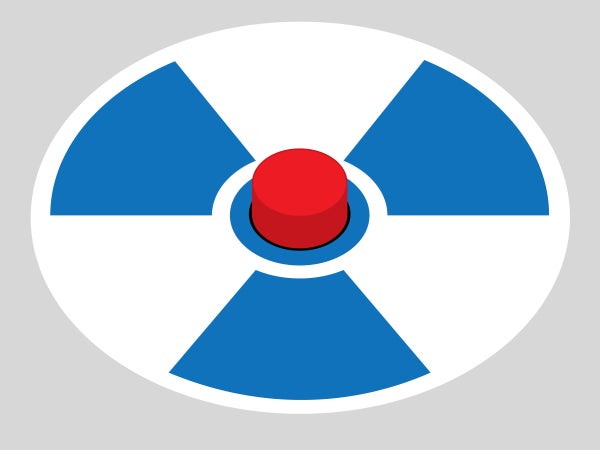Politics tamfitronics
October 3, 2024
5 min read
Politics tamfitronics
The Next President Faces Tough Nuclear Weapons Deadlines
Whoever wins the 2024 presidential election will face heightened nuclear geopolitics, deadlines on nuclear deals with Russia and Iran and decisions on a $2-trillion weapons-modernization effort
By Daniel Vergano

Thomas Fuchs
This article is part of a series on what the 2024 presidential election means for science, health and the environment. Editors with expertise on each topic delved into the candidates’ records and policies and the evidence behind them.
Amid the many dangers facing the world, questions about the direction of U.S. nuclear policy—and control of the nuclear button—have received surprisingly little attention in the 2024 election, nuclear policy experts say. “Overall, the missing story is why there isn’t more argument about nuclear weapons at precisely a time when the commander in chief might be unstable and in a world where Russia has repeatedly made nuclear threats,” says national security expert Sharon Weiner, an associate professor in the School of International Service at American University.
But she and others say even without clear plans from the campaigns of former president Donald Trump and current vice president Kamala Harris, we can use past actions to glean some insights into what to expect for nuclear weapons policy with a new administration. “We do have some data to base our projections on in the past behavior of both the Trump and the Biden administrations,” says Daryl G. Kimball, executive director of the Arms Control Association, a nonprofit dedicated to promoting support for effective arms control.
Nine nations worldwide possess some 12,000 nuclear weapons, with the great majority owned by the U.S. and Russia, according to the Federation of American Scientists, a nonprofit think tank focused on global security. Whoever wins the election, the next president faces hard choices—and hard treaty deadlines—on U.S. nuclear arms, which comprise roughly 5,000 weapons, with 1,700 deployed for military use. In 2023 Russia, angered by Western sanctions over its invasion of Ukraine, suspended new inspections under the Strategic Arms Reduction Treaty (START), which limits it and the U.S to no more than 1,550 deployed, conflict-ready nuclear warheads. A renewed START treaty with Russia must come in 2026 to forestall a possible renewed arms race, and an international agreement with Iran to limit its nuclear program expires in 2025, after which that regime may then break out of the agreement and come to possess nuclear weapons. China may also double its current force of 500 weapons by 2030, according to a Pentagon report, raising calls by defense hawks for a response.
Politics tamfitronics On supporting science journalism
If you’re enjoying this article, consider supporting our award-winning journalism by subscribing. By purchasing a subscription you are helping to ensure the future of impactful stories about the discoveries and ideas shaping our world today.
If Harris wins, she would inherit the policies of President Joe Biden, who has embraced nuclear diplomacy, earlier extending the START arms control agreement with Russia in 2021 while also continuing a $2-trillion modernization of U.S. nuclear arms. That decade-old effort, which began under then president Barack Obama, is now plagued by skyrocketing costs and, outside of boosters in Congress, faces questions about its necessity. (Congress notably funded a sea-launched nuclear cruise missile program that was rejected by the Biden administration. The Center for Arms Control and Non-Proliferation called the program “unwanted, costly and redundant.”) Harris would also inherit a classified strategic nuclear plan from Biden that is reportedly aimed at countering China’s arms buildup and coordinated nuclear attacks from that country, Russia and North Korea.
Where the Biden administration has sought to engage with Russia on the expiring START treaty, in 2020 Trump had instead sought a three-way agreement with Russia and China in the face of its earlier expiration. (His arms envoy had then threatened to spend those two nations “into oblivion” in a new arms race when that effort failed.) New leadership in Iran has raised the possibility of a new agreement to limit nuclear arms development in exchange for eased sanctions. Iran’s conflict with Israel and military assistance to Russia, however, has complicated the Biden administration’s diplomatic efforts toward a deal. Trump pulled the U.S. from a previous expiring deal in 2018 and seems unlikely to make a new one, Kimball says.
Looming large over the question of how the U.S. will handle nuclear negotiations in the future are also questions about former president Trump’s temperament, illustrated by his 2017 threat to unleash “fire and fury” on North Korea while in office, his past decision to end a nuclear agreement with Iran and his approach to Russian president Vladimir Putin, who has resorted to nuclear brinksmanship in his invasion of Ukraine. Middlebury Institute nuclear weapons expert Jeffrey Lewis penned a 2018 speculative fiction novel, The 2020 Commission Report on the North Korean Nuclear Attacks Against the United Statesthat laid out the chances of a horrific nuclear war driven by Trump’sunrealistic expectations and lack of understanding of nuclear issues. Those fears are still held today in nuclear policy circles: “Donald Trump’s good old friend Kim Jong Un is still out there and more well-armed than ever,” Kimball says. “From a temperament perspective, we have to ask, ‘How would today’s Trump handle a crisis that could lead to real nuclear escalation?’”
Among the few mentions of nuclear war so far in the campaign, Trump referenced Putin’s threats to drop nuclear weapons on Ukraine as possibly leading to “World War III” at the September debate with Harris but didn’t elaborate on how he would handle that situation.
Trump has often extolled his ability to work directly with overseas leaders in his campaign remarks on geopolitics, touting what he says are good relationships with both Putin and Ukraine’s president Volodymyr Zelensky to end their war, for example. His courting of North Korea’s leader Kim Jong Un, ostensibly aimed at getting that nation to denuclearize, was followed by a failed summit in 2019, however. Since then North Korea has increased its nuclear weapon numbers to 50 or more while also testing new missiles.
The Project 2025 blueprint for a second Trump administration—authored by former Trump officials—would pursue an even more aggressive expansion of the U.S. nuclear arsenal than is currently underway. (Trump has disavowed Project 2025, but few observers credit his demurrals.) Notably, the plan calls for testing nuclear weapons at the Nevada National Security Site, even though underground detonations would violate the 1996 Comprehensive Nuclear-Test-Ban Treaty (CTBT), which the U.S. has signed but not ratified, though it has not conducted tests since 1992. North Korea is not a CTBT signatory and last conducted a test in 2017.
In the big picture, campaign differences on nuclear policy are more matters of degree, Weiner says, leaving unasked the role the U.S. modernization played in buildups elsewhere or even the need for its costs in the public mind. In political discussions, “there seems to be a consensus not just on nuclear modernization but that the appropriate response to Russia and China is at least to consider building more and different nuclear weapons,” she says. “I think the big story, and one that is not reported, is that after the election, nuclear policy is likely to be the one area that is not going to change.”
Discover more from Tamfis
Subscribe to get the latest posts sent to your email.







